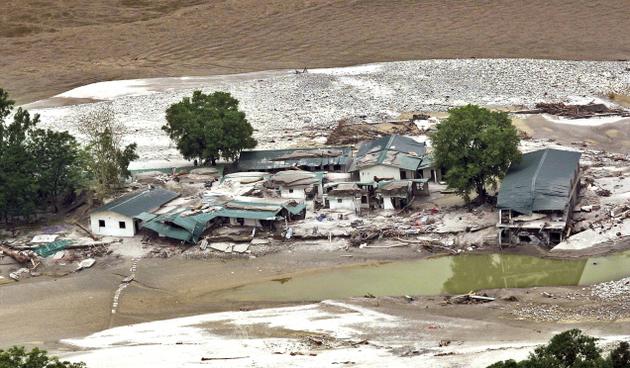Uttarkhand Floods: Nature Fights Back, Exploited Beyond Reason

New Delhi, June 26, 2013: On the fateful day a cloudburst. The rains lashed the mountains. The mountains moved bringing down everything that came their way, wrecking havoc. The Army, the Indian Air Force and ITBP continue to battle the tough terrains to rescue the stranded people in this national calamity.
“But how many people reach there, season after season, have we ever wondered? Where is the space for so many people? How come so many hotels, restaurants and other structures were allowed to come up there?,” asks Satyabrata Dam, an adventure consultant and an extreme mountaineer, who has witnessed the rapid downfall of the hilly region first-hand on account of his frequent visits to the State. “This was a tragedy waiting to happen. Ecologically, this is nature’s balancing act. Some responsibility rests with us as well. To support such large number of tourists, you need adequate infrastructure — hotels, restaurants, shops etc.,” opines Dam.
Cloudbursts, flash-floods and rains are all natural phenomenon. But could we have done something that would have brought down the numbers of lives lost? “Only if we had not allowed so many people to go there at once,” he says. Thousands have been rescued and thousands have been killed and several are still stuck there. “Rescuing would have been faster, fewer lives would have been lost and the road to recovery would have been automatically faster,” he says.
Unrestricted entry, faulty architecture, local corruption and administrative indifference; these are all causes thrown at you when you try to find facts leading to the Uttarakhand disaster. However, it may actually be a mixture of many faults that led to the tragedy. The lessons in avoiding disaster and managing it are not far to seek. To control the crowds at the time of annual Haj, the Saudi Government allots quotas to different countries and this year it has requested India to reduce the number of pilgrims by 20 per cent. However, this year, the numbers have been reduced further in the wake of massive infrastructure expansion undergoing in Mecca. The authorities will also be reducing the number of local pilgrims by 50 per cent. The mandatory health certificate that a Haj pilgrim has to submit creates yet another check. “Nobody can proceed without this health check-up. The check-up is done by authorized doctors only,” says Parvez Mian, Chairman, Delhi State Haj Committee.
Back in India, the Amarnath yatra is better regulated. Shri Amarnath Shrine Board (SASB) has become strict with its health advisory and the pilgrims require a compulsory health certificate under which the individual has to undergo various medical tests to establish if they are fit to undertake the exacting journey. “If not as arduous as Amarnath, Kedarnath is also situated at a high altitude, so you need to be equally fit to go there but why it has not been done so far? The mandatory health check-up will act as a deterrent for people to go there. Age limits should also be introduced wherein only people between 16 to 60 years of age should be allowed to travel in such extreme conditions and divide the number of people going to these places on the basis of how much pressure can be exerted on the fragile eco-system,” suggests Dam.
Pankaj Doval, the owner of A1 Tours and Travels, a Delhi-based private tour and travel operator, tells us that while four out of five tourists he had sent there this time returned but a 50-year-old lady died in the stampede at Kedarnath temple. “No mandatory health check-up is required. We simply tell the tourists about low oxygen levels and ask them to keep themselves hydrated,” says Doval.
Doval belongs to the hills and says he doesn’t remember any disaster of a similar scale. Yes, these weather conditions are not commonplace but the massive pressure of the tourism industry has increased the frequency of landslides and floods in recent years. Delhi-based Vinod Singhal lost his school-going son to landslide a few years ago. “Lack of medical facilities killed him…there was not even adequate oxygen. How can there be with so many people around?” he asks.
Confirming Singhal’s claim, Dam says a few medical centres in Kedarnath and Rambara are not enough and provide only extremely basic services. Rampant corruption that led to flouting of rules, has also added its bit to the mayhem. “After sundown one is not allowed to go beyond Pipalkoti. But our driver bribed the guards and drove us in pitch dark to Joshimath. It was a bus full of people, there were no street lights. Anything could have happened to us,” recalls a tourist who travelled to Badrinath in 2004. That year, some pilgrims died due to landslide in Hemkund Sahib.
Architecturally too, the place is a disaster. “Just earlier this year we were discussing the idea of starting an institute to teach mountain architecture in Uttarakhand with forest officials there. Because there are absolutely no guidelines for building structures there. You find city-like buildings there, which is completely incorrect. The traditionally made structures in Uttarakhand had a wooden framework on top and concrete at the bottom level but the new structures aren’t made like this. How can you build on the river bed? How can you build on slopes? How can you make three-four floor level buildings there? These rivers Ganga and Yamuna, keep changing their courses. The construction should be done accordingly,” states architect Himanshu Lal of Arch I, a design and architecture company which has been actively working in the region for some time now. Practicing sustainable architecture, it has made various maps of Uttarakhand eco-tourism map, Ramganga river and Choti Haldwani, in order to raise awareness.
Source: The Hindu, DT. June 26, 2013.







